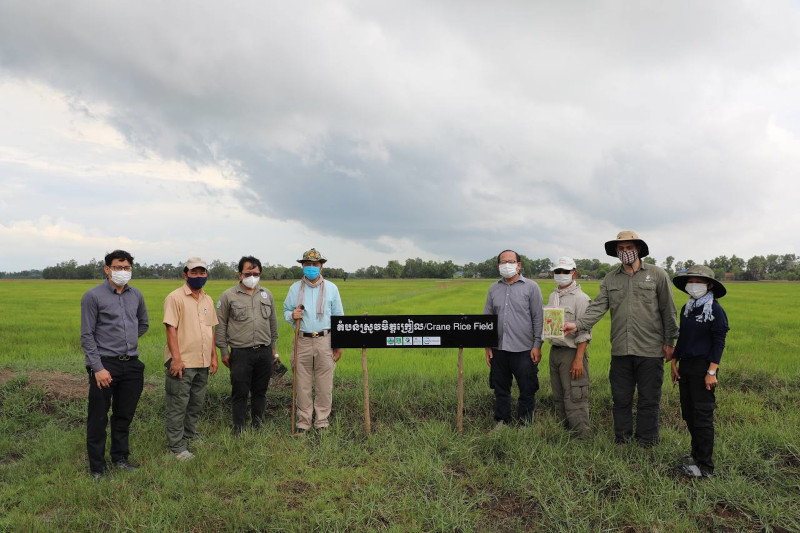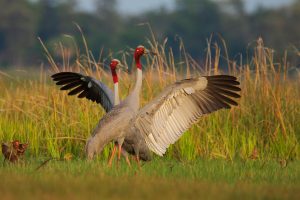
‘Sarus Crane Rice’ ©Ministry of Environment of Cambodia & NatureLife Cambodia
The Ministry of Environment of Cambodia, in collaboration with NatureLife Cambodia and BirdLife International, has now established a new ‘Crane Rice’ initiative, aimed at improving local livelihoods and better conserving the stately Sarus Crane. ‘Crane Rice’ will involve wildlife-friendly rice farming practices which will benefit the cranes and other waterbirds in Anlung Pring Protected landscape, the first Flyway Network Site in Cambodia (EAAF144) located in Boeung Salang Kang Tbaung and Prek Kruss communes, Kampong Trach district, Kampot Province, Cambodia.
Under this initiative, participating farmers need to grow native and crane-preferred rice varieties. They also need to adhere to the guidelines for crane rice. This means that the farmers cannot hunt and snare wildlife on their plots, and apply poisons. Farmers are also expected to avoid encroaching on protected lands and encouraged to adopt organic rice farming (i.e. no application of chemicals fertilizers and herbicides). Half of the rice grown on leased land, will be harvested and packaged for sale while the remainder will be left in the fields to benefit Sarus Cranes and other biodiversity.
For crane conservation and protection to be successful, it needs to consider local livelihoods and engagement with stakeholders. The Ministry of Environment will continue to collaborate with our NGO partners to find markets for Crane Rice to ensure the success of the pilot programmes, while encouraging farmers to participate in this initiative and working to ensure that the rice can be sold at a premium.

©Ministry of Environment of Cambodia & NatureLife Cambodia
Since its pilot inception which supported by IUCN-Netherland, the project team have collaborated with 16 farmers and over 10 years, leased 17 hectares of rice fields to pilot work to grow crane-friendly rice, thereby benefiting local livelihoods. The number of farmers who have participated in this Crane Rice initiative increased this year, which is very encouraging.

Local farmers planting the seeds ©Ministry of Environment of Cambodia & NatureLife Cambodia
The permanently based rangers are collaborating with the local authorities and partner NGO to educate local people about the legislation that protects wildlife and the value of rare bird species, especially the Sarus Crane. The Crane Rice Initiative has provided supplementary feeding for the cranes that annually visit our site during their non-breeding season.
Mr. Teup Khay, a farmer from Kok Chamkar, was appreciated for joining the Sarus Crane rice pilot project as it provided him with additional income. At the same time, his family are growing rice without the use of chemical fertilizers and pesticides that can help to provide safer food, which they are very proud of. Moreover, If the cranes are better conserved, they will also help to attract more tourists, who would also enjoy the local culture, and hospitality of their communities.
About Sarus Crane:
Sarus Crane is one of the crane species in EAAFlyway. There is mainly only one species of cranes in Southeast Asia. It is a short-distant migrant between Vietnam and Cambodia, including a re-introduction programme in Thailand.
Based on the findings of the 2020 Sarus Crane census in Cambodia, only 194 birds have been recorded, an all-time low. In the last few years, the number of cranes has declined steadily due to the high mortality rate and low nesting success in its breeding grounds. Additional threats faced by the cranes include deteriorating habitat conditions, poisoning caused by pesticide use, lack of food, change in water regimes at key wetlands, diseases, and in the long-term, climate change.

Sarus Crane © Ayuwat Jearwattanakanok
Article prepared by The Ministry of Environment of Cambodia.




